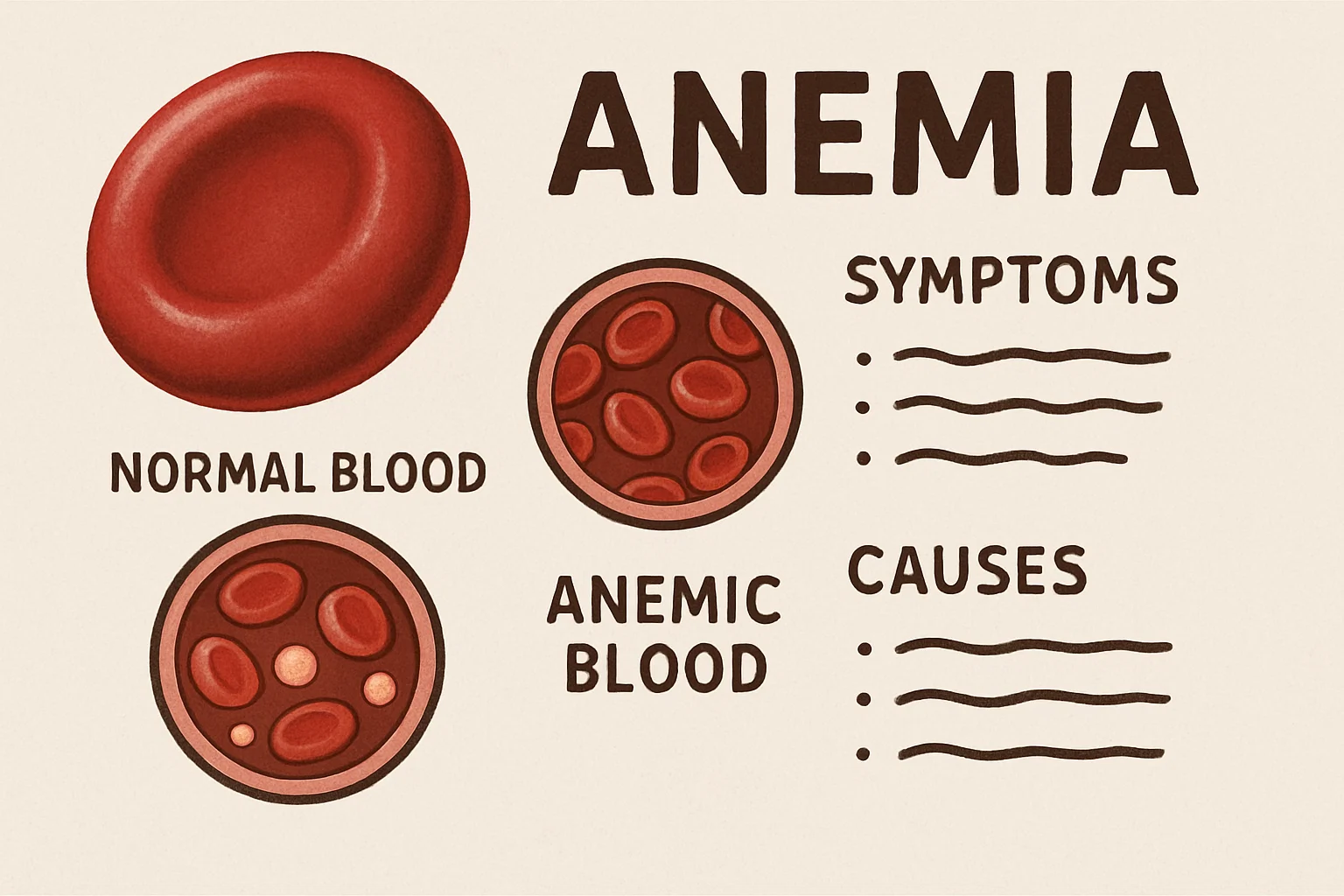Anemia is a condition in which the body lacks enough red blood cells or has a lower-than-normal level of hemoglobin (Hb). Hemoglobin is a vital protein in red blood cells that carries oxygen throughout the body, helping organs function properly. Normal hemoglobin levels range from 13.5–17.5 g/dL for men and 12–15.5 g/dL for women. A person is considered anemic if their Hb level falls below these values—less than 13.5 g/dL in men and less than 12 g/dL in women.
But what exactly causes anemia? To better understand this condition, it’s important to know the factors that can lead to a drop in hemoglobin levels. By recognizing the causes early on, we can take the right preventive measures and maintain our overall health.
Causes of Anemia
Anemia doesn’t happen overnight. It can result from several factors, including medical conditions, poor nutrition, or everyday habits that unknowingly affect blood health.
Common causes of anemia include:
- Nutritional Deficiencies
A lack of essential nutrients—such as iron, vitamin B12, folic acid, vitamin A, and protein—can hinder red blood cell production. Iron, for example, is a key component of hemoglobin. Without enough iron, the body struggles to produce healthy red blood cells. - Chronic Inflammation
Long-term inflammation, such as from autoimmune diseases or chronic infections, can disrupt the bone marrow’s ability to produce red blood cells, leading to lower hemoglobin levels. - Parasitic Infections
Parasitic infections like hookworms or malaria can cause anemia by directly damaging red blood cells or causing slow, ongoing blood loss. - Genetic Conditions
Inherited blood disorders like thalassemia or sickle cell anemia can affect the body’s ability to produce red blood cells. These conditions are usually detected at a young age and require long-term management. - Iron Loss During Menstruation
Heavy menstrual bleeding, injury, surgery, or internal bleeding (such as in the digestive tract) can all lead to significant blood loss and result in anemia if not properly treated. - Physiological Processes
Natural life phases like pregnancy, breastfeeding, and menstruation increase the body’s need for iron and other nutrients. Without adequate intake, these stages can raise the risk of anemia, especially for women. - Age and Gender
Women of reproductive age are more likely to experience anemia due to regular blood loss during menstruation. Older adults, on the other hand, may have reduced nutrient absorption, increasing their risk for anemia caused by nutritional deficiencies.
Anemia often develops silently, triggered by everyday habits—skipping meals, eating fewer vegetables, or ignoring constant fatigue. The good news is that anemia can be prevented and managed. Our bodies give us signals when something isn’t right. Our job is to listen, understand, and take better care of ourselves.
Symptoms of Anemia
Anemia can present with a variety of symptoms depending on its severity. Some people may feel slightly tired, while others may suffer organ-related issues due to reduced oxygen supply.
Early or Mild Symptoms of Anemia:
- Pale Skin and Face: Especially noticeable in the face, palms, and inner eyelids due to decreased hemoglobin levels.
- Fatigue: Feeling tired or lacking energy even after light daily activities.
- Mild Rapid Heartbeat (Tachycardia): The heart beats faster to compensate for low oxygen levels.
- Difficulty Concentrating: Trouble focusing or feeling mentally “blank” may indicate low oxygen supply to the brain.
- Dizziness or Light Headedness: Especially after standing up from a sitting or lying position.
Severe Anemia Symptoms (If Left Untreated):
- Extreme Fatigue (Lethargy): Feeling too weak to carry out daily tasks, even with adequate rest.
- Irregular Heartbeat (Arrhythmia): The heart may beat too fast, too slow, or irregularly due to oxygen shortage.
- Heart Murmurs: Abnormal heart sounds detected during a medical check-up.
- Chest Pain (Angina): The heart works harder without enough oxygen, causing pain especially during physical activity.
- Shortness of Breath: Poor oxygenation can make it hard to breathe, even at rest.
- Confusion or Disorientation: A lack of oxygen to the brain may cause cognitive issues such as brain fog or confusion.
- Serious Complications: In severe cases, anemia can lead to heart failure, heart attacks, and damage to other organs.
Why Women Are More Vulnerable to Anemia
Women face certain biological processes that make them more susceptible to anemia compared to men. Factors like menstruation, pregnancy, childbirth, and breastfeeding all increase the risk of blood and iron loss.
- Menstruation:
Monthly periods cause natural blood loss. If a woman experiences prolonged or heavy bleeding, she may lose a significant amount of iron, increasing the risk of iron-deficiency anemia—the most common type among women. - Pregnancy:
During pregnancy, blood volume increases significantly to support both the mother and the developing baby. This increases the need for iron to produce hemoglobin and ensure healthy fetal growth. Morning sickness can also hinder the absorption of important nutrients, including iron. - Childbirth and Breastfeeding:
Childbirth often involves substantial blood loss, which can result in postpartum anemia. Breastfeeding also increases nutritional needs. Without proper nutrition—especially adequate iron—nursing mothers may feel weak and have a weakened immune system due to anemia.
How to Prevent Anemia
Preventing anemia doesn’t always require complex treatments. Simple daily steps can help you maintain healthy hemoglobin levels and stay energized:
- Eat Iron-Rich Foods
Iron is essential for forming hemoglobin. Good sources include:
- Red meat, fish, and poultry (heme iron, easily absorbed)
- Green leafy vegetables like spinach, broccoli, and moringa leaves
- Legumes such as soybeans, lentils, and kidney beans
- Iron-fortified foods like cereals, bread, and dairy products - Combine Iron with Vitamin C
Iron from plant-based sources (non-heme iron) is harder for the body to absorb. To enhance absorption, pair it with vitamin C-rich foods like oranges, strawberries, tomatoes, or bell peppers. - Avoid Coffee or Tea During Meals
Caffeinated drinks contain tannins that interfere with iron absorption. It’s best to wait 1–2 hours after eating before drinking coffee or tea. - Take Iron Supplements if Needed
People at higher risk—such as pregnant women, breastfeeding mothers, or teenage girls—may benefit from iron supplements. Always consult a healthcare provider before taking supplements to avoid potential side effects or overdose. - Maintain a Balanced and Consistent Diet
A daily diet that includes carbohydrates, proteins, healthy fats, vitamins, and minerals supports optimal red blood cell production. Don’t skip meals and ensure you’re meeting your body’s nutritional needs regularly. - Anemia is preventable through consistent small habits—from your plate to your daily routine. So don’t wait for the symptoms to appear. Start taking care of your body today!
Sources:
- Muhayati, A., & Ratnawati, D. (2019). The Relationship Between Nutritional Status and Eating Patterns with the Incidence of Anemia in Adolescent Girls. Jurnal Ilmiah Ilmu Keperawatan Indonesia, 9(1).
- Ariana, R., & Fajar, N. A. (2024). Risk Factors for Anemia in Adolescent Girls: A Literature Review. Jurnal Kesehatan Komunitas, 10(1), 133–140.
- Asmara, A. N., et al. (2022). Health Counseling to Increase Knowledge about Anemia in Adolescents. KOLABORASI: Inspirasi Masyarakat Madani, 2(3), 254–261.
- Halodoc.com. (Why Women Are More Prone to Anemia), accessed on July 24, 2025.
- Cholidah, R., et al. (2024). Education on Anemia Prevention and Hemoglobin Testing for Adolescent Girls in Mataram. Jurnal Pengabdian Magister Pendidikan IPA, 7(4), 1751–1754.

